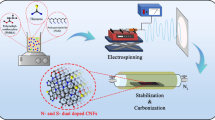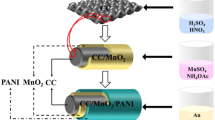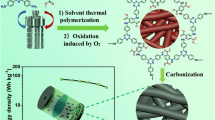Abstract
Heteroatom-doped carbon materials have attracted immense interest as advanced supercapacitor electrode materials due to their unique properties. A carbon cloth-supported, nitrogen-doped carbon “spider web” network full of macropores and mesopores is developed via the pyrolysis of polyaniline nanofibers in ammonia atmosphere. The presence of mesopores and macropores can provide ion-buffering reservoirs to shorten the ion diffusion distance to the interior part of the carbon network. Carbonization in ammonia introduced N heteroatoms through gas phase chemical reactions between ammonia and the oxygen functionalities on the carbon surface. The enhanced ion-accessible surface area and improved charge transfer rate can be achieved. The N-doped carbon “spider web” exhibited a high specific capacitance of 266 F/g at a scan rate of 2 mV/s. Even when the scan rate was increased to 500 mV/s, 61% of its capacitance could still be retained, evidencing its excellent rate performance. The demonstrated strategy is anticipated to be generally effective for preparing heteroatom-doped carbon electrodes with other polymers.





Similar content being viewed by others
References
V. Augustyn, P. Simon, and B. Dunn: Pseudocapacitive oxide materials for high-rate electrochemical energy storage. Energy Environ. Sci. 7, 1597 (2014).
L.F. Chen, X.D. Zhang, H.W. Liang, M. Kong, Q.F. Guan, P. Chen, Z.Y. Wu, and S.H. Yu: Synthesis of nitrogen-doped porous carbon nanofibers as an efficient electrode material for supercapacitors. ACS Nano 6, 7092 (2012).
S. Dutta, A. Bhaumik, and K.C.W. Wu: Hierarchically porous carbon derived from polymers and biomass: Effect of interconnected pores on energy applications. Energy Environ. Sci. 7, 3574 (2014).
D-Y. Feng, Y. Song, Z-H. Huang, X-X. Xu, and X-X. Liu: Rate capability improvement of polypyrrole via integration with functionalized commercial carbon cloth for pseudocapacitor. J. Power Sources 324, 788 (2016).
T. Liu, F. Zhang, Y. Song, and Y. Li: Revitalizing carbon supercapacitor electrodes with hierarchical porous structures. J. Mater. Chem. A 5, 17705 (2017).
T. Zhai, X. Lu, H. Wang, G. Wang, T. Mathis, T. Liu, C. Li, Y. Tong, and Y. Li: An electrochemical capacitor with applicable energy density of 7.4 W h/kg at average power density of 3000 W/kg. Nano Lett. 15, 3189 (2015).
M. Yu, D. Lin, H. Feng, Y. Zeng, Y. Tong, and X. Lu: Boosting the energy density of carbon-based aqueous supercapacitors by optimizing the surface charge. Angew. Chem., Int. Ed. 56, 5454 (2017).
M. Yu, S. Zhao, H. Feng, L. Hu, X. Zhang, Y. Zeng, Y. Tong, and X. Lu: Engineering thin MoS2 nanosheets on TiN nanorods: Advanced electrochemical capacitor electrode and hydrogen evolution electrocatalyst. ACS Energy Lett. 2, 1862 (2017).
Y. Zeng, M. Yu, Y. Meng, P. Fang, X. Lu, and Y. Tong: Iron-based supercapacitor electrodes: Advances and challenges. Adv. Energy Mater. 6, 1601053 (2016).
X. Lu, T. Liu, T. Zhai, G. Wang, M. Yu, S. Xie, Y. Ling, C. Liang, Y. Tong, and Y. Li: Improving the cycling stability of metal-nitride supercapacitor electrodes with a thin carbon shell. Adv. Energy Mater. 4, 1300994 (2014).
X. Lu, M. Yu, G. Wang, T. Zhai, S. Xie, Y. Ling, Y. Tong, and Y. Li: H–TiO2@MnO2//H–TiO2@C core–shell nanowires for high performance and flexible asymmetric supercapacitors. Adv. Mater. 25, 267 (2013).
Y. Song, T. Liu, B. Yao, M. Li, T. Kou, Z-H. Huang, D-Y. Feng, F. Wang, Y. Tong, X-X. Liu, and Y. Li: Ostwald ripening improves rate capability of high mass loading manganese oxide for supercapacitors. ACS Energy Lett. 2, 1752 (2017).
Y. Song, T.Y. Liu, B. Yao, T.Y. Kou, D.Y. Feng, X.X. Liu, and Y. Li: Amorphous mixed-valence vanadium oxide/exfoliated carbon cloth structure shows a record high cycling stability. Small 13, 1700067 (2017).
T. Zhai, L. Wan, S. Sun, Q. Chen, J. Sun, Q. Xia, and H. Xia: Phosphate ion functionalized Co3O4 ultrathin nanosheets with greatly improved surface reactivity for high performance pseudocapacitors. Adv. Mater. 29, 1604167 (2017).
B. Yao, L. Huang, J. Zhang, X. Gao, J. Wu, Y. Cheng, X. Xiao, B. Wang, Y. Li, and J. Zhou: Flexible transparent molybdenum trioxide nanopaper for energy storage. Adv. Mater. 28, 6353 (2016).
F. Zhang, T. Liu, M. Li, M. Yu, Y. Luo, Y. Tong, and Y. Li: Multiscale pore network boosts capacitance of carbon electrodes for ultrafast charging. Nano Lett. 17, 3097 (2017).
Y. Song, T. Liu, F. Qian, C. Zhu, B. Yao, E. Duoss, C. Spadaccini, M. Worsley, and Y. Li: Three-dimensional carbon architectures for electrochemical capacitors. J. Colloid Interface Sci., 509, 529 (2017).
B. Yao, J. Zhang, T. Kou, Y. Song, T. Liu, and Y. Li: Paper-based electrodes for flexible energy storage devices. Adv. Sci. 4, 1700107 (2017).
D.W. Wang, F. Li, M. Liu, G.Q. Lu, and H.M. Cheng: 3D aperiodic hierarchical porous graphitic carbon material for high-rate electrochemical capacitive energy storage. Angew. Chem., Int. Ed. 47, 373 (2008).
W. Zhang, H. Lin, Z. Lin, J. Yin, H. Lu, D. Liu, and M. Zhao: 3D hierarchical porous carbon for supercapacitors prepared from lignin through a facile template-free method. ChemSusChem 8, 2114 (2015).
F. Zhang, T. Liu, G. Hou, T. Kou, L. Yue, R. Guan, and Y. Li: Hierarchically porous carbon foams for electric double layer capacitors. Nano Res. 9, 2875 (2016).
D-s. Yuan, T-x. Zhou, S-l. Zhou, W-j. Zou, S-s. Mo, and N-n. Xia: Nitrogen-enriched carbon nanowires from the direct carbonization of polyaniline nanowires and its electrochemical properties. Electrochem. Commun. 13, 242 (2011).
S. Chaudhari, S.Y. Kwon, and J-S. Yu: Ordered multimodal porous carbon with hierarchical nanostructure as high performance electrode material for supercapacitors. RSC Adv. 4, 38931 (2014).
Q. Wang, J. Yan, Y. Wang, T. Wei, M. Zhang, X. Jing, and Z. Fan: Three-dimensional flower-like and hierarchical porous carbon materials as high-rate performance electrodes for supercapacitors. Carbon 67, 119 (2014).
S. Zhu, J. Li, C. He, N. Zhao, E. Liu, C. Shi, and M. Zhang: Soluble salt self-assembly-assisted synthesis of three-dimensional hierarchical porous carbon networks for supercapacitors. J. Mater. Chem. A 3, 22266 (2015).
J.K. Ewert, D. Weingarth, C. Denner, M. Friedrich, M. Zeiger, A. Schreiber, N. Jäckel, V. Presser, and R. Kempe: Enhanced capacitance of nitrogen-doped hierarchically porous carbide-derived carbon in matched ionic liquids. J. Mater. Chem. A 3, 18906 (2015).
J. Han, G. Xu, B. Ding, J. Pan, H. Dou, and D.R. MacFarlane: Porous nitrogen-doped hollow carbon spheres derived from polyaniline for high performance supercapacitors. J. Mater. Chem. A 2, 5352 (2014).
J. Hou, C. Cao, F. Idrees, and X. Ma: Hierarchical porous nitrogen-doped carbon nanosheets derived from silk for ultrahigh-capacity battery anodes and supercapacitors. ACS Nano 9, 2556 (2015).
L. Lai, J.R. Potts, D. Zhan, L. Wang, C.K. Poh, C. Tang, H. Gong, Z. Shen, J. Lin, and R.S. Ruoff: Exploration of the active center structure of nitrogen-doped graphene-based catalysts for oxygen reduction reaction. Energy Environ. Sci. 5, 7936 (2012).
L. Qie, W. Chen, H. Xu, X. Xiong, Y. Jiang, F. Zou, X. Hu, Y. Xin, Z. Zhang, and Y. Huang: Synthesis of functionalized 3D hierarchical porous carbon for high-performance supercapacitors. Energy Environ. Sci. 6, 2497 (2013).
W. Luo, B. Wang, C.G. Heron, M.J. Allen, J. Morre, C.S. Maier, W.F. Stickle, and X. Ji: Pyrolysis of cellulose under ammonia leads to nitrogen-doped nanoporous carbon generated through methane formation. Nano Lett. 14, 2225 (2014).
G. Wang, H. Wang, X. Lu, Y. Ling, M. Yu, T. Zhai, Y. Tong, and Y. Li: Solid-state supercapacitor based on activated carbon cloths exhibits excellent rate capability. Adv. Mater. 26, 2676 (2014).
Q.e. Zhang, A. Zhou, J. Wang, J. Wu, and H. Bai: Degradation-induced capacitance: A new insight into the superior capacitive performance of polyaniline/graphene composites. Energy Environ. Sci., 10, 2372 (2017).
Y. Luo, D. Kong, Y. Jia, J. Luo, Y. Lu, D. Zhang, K. Qiu, C.M. Li, and T. Yu: Self-assembled graphene@PANI nanoworm composites with enhanced supercapacitor performance. RSC Adv. 3, 5851 (2013).
L. Wang, Q. Yao, H. Bi, F. Huang, Q. Wang, and L. Chen: PANI/graphene nanocomposite films with high thermoelectric properties by enhanced molecular ordering. J. Mater. Chem. A 3, 7086 (2015).
Z.H. Huang, T.Y. Liu, Y. Song, Y. Li, and X.X. Liu: Balancing the electrical double layer capacitance and pseudocapacitance of hetero-atom doped carbon. Nanoscale, 9, 13119 (2017).
D. Hulicova-Jurcakova, M. Kodama, S. Shiraishi, H. Hatori, Z.H. Zhu, and G.Q. Lu: Nitrogen-enriched nonporous carbon electrodes with extraordinary supercapacitance. Adv. Funct. Mater. 19, 1800 (2009).
M. Yang, Y. Zhong, J. Bao, X. Zhou, J. Wei, and Z. Zhou: Achieving battery-level energy density by constructing aqueous carbonaceous supercapacitors with hierarchical porous N-rich carbon materials. J. Mater. Chem. A 3, 11387 (2015).
Z. Li, Z. Xu, H. Wang, J. Ding, B. Zahiri, C.M.B. Holt, X. Tan, and D. Mitlin: Colossal pseudocapacitance in a high functionality–high surface area carbon anode doubles the energy of an asymmetric supercapacitor. Energy Environ. Sci. 7, 1708 (2014).
Y. Song, T-Y. Liu, G-L. Xu, D-Y. Feng, B. Yao, T-Y. Kou, X-X. Liu, and Y. Li: Tri-layered graphite foil for electrochemical capacitors. J. Mater. Chem. A 4, 7683 (2016).
L. Li, E. Liu, J. Li, Y. Yang, H. Shen, Z. Huang, X. Xiang, and W. Li: A doped activated carbon prepared from polyaniline for high performance supercapacitors. J. Power Sources 195, 1516 (2010).
Y. Song, J-L. Xu, and X-X. Liu: Electrochemical anchoring of dual doping polypyrrole on graphene sheets partially exfoliated from graphite foil for high-performance supercapacitor electrode. J. Power Sources 249, 48 (2014).
Z. Li, L. Zhang, B.S. Amirkhiz, X. Tan, Z. Xu, H. Wang, B.C. Olsen, C.M.B. Holt, and D. Mitlin: Carbonized chicken eggshell membranes with 3D architectures as high-performance electrode materials for supercapacitors. Adv. Energy Mater. 2, 431 (2012).
ACKNOWLEDGMENTS
Xiao-Xia Liu gratefully acknowledges financial support from National Natural Science Foundation of China (Nos. 21273029 and 21673035). Yat Li acknowledges support by National Aeronautics and Space Administration (NASA) Grant No. NNX15AQ01. Yu Song acknowledges the financial support from China Scholarship Council. We also acknowledge the help for SEM image acquisition offered by Dr. Tom Yuzvinsky from the W.M. Keck Center for Nanoscale Opto-fluidics at the University of California, Santa Cruz.
Author information
Authors and Affiliations
Corresponding authors
Additional information
This author was an editor of this journal during the review and decision stage. For the JMR policy on review and publication of manuscripts authored by editors, please refer to http://www.mrs.org/editor-manuscripts/.
Rights and permissions
About this article
Cite this article
Song, Y., Qin, Z., Huang, Z. et al. Nitrogen-doped carbon “spider webs” derived from pyrolysis of polyaniline nanofibers in ammonia for capacitive energy storage. Journal of Materials Research 33, 1109–1119 (2018). https://doi.org/10.1557/jmr.2017.443
Received:
Accepted:
Published:
Issue Date:
DOI: https://doi.org/10.1557/jmr.2017.443




